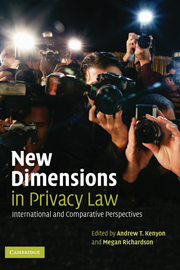Book contents
- Frontmatter
- Contents
- List of contributors
- Preface
- 1 New dimensions in privacy: Communications technologies, media practices and law
- 2 Privacy and freedom of speech
- 3 Revisiting the American action for public disclosure of private facts
- 4 The internet and private life in Europe: Risks and aspirations
- 5 APEC's privacy framework sets a new low standard for the Asia-Pacific
- 6 Copyright, privacy and digital rights management (DRM)
- 7 Why there will never be an English common law privacy tort
- 8 The ‘right’ of privacy in England and Strasbourg compared
- 9 Privacy and constitutions
- 10 Celebrity privacy and benefits of simple history
- Bibliography
- Index
- Index of laws and directives
- Index of case references
6 - Copyright, privacy and digital rights management (DRM)
Published online by Cambridge University Press: 24 July 2009
- Frontmatter
- Contents
- List of contributors
- Preface
- 1 New dimensions in privacy: Communications technologies, media practices and law
- 2 Privacy and freedom of speech
- 3 Revisiting the American action for public disclosure of private facts
- 4 The internet and private life in Europe: Risks and aspirations
- 5 APEC's privacy framework sets a new low standard for the Asia-Pacific
- 6 Copyright, privacy and digital rights management (DRM)
- 7 Why there will never be an English common law privacy tort
- 8 The ‘right’ of privacy in England and Strasbourg compared
- 9 Privacy and constitutions
- 10 Celebrity privacy and benefits of simple history
- Bibliography
- Index
- Index of laws and directives
- Index of case references
Summary
The combination of tracking technology and online licensing on the one hand, and extra-copyright limitations based in privacy rights on the other, would in my opinion yield a better copyright regime than many national laws now afford with respect to the problem of private copying.
Jane C. GinsburgIntroduction
The quotation from Jane Ginsburg provides a useful entry point into the subject of this chapter: the relationship between copyright law, privacy laws and the emerging phenomenon of digital rights management (DRM). There can be little doubt that the production and distribution of copyright-protected material in digital form has created challenges for its owners, in particular new horizons for seemingly endless forms of infringement by users. These challenges have, in turn, spawned DRM systems and technologies that are designed to deter infringement and facilitate management of rights in new and different ways and which may well provide copyright owners with more control over their material and over users than was possible in the non-digital environment. The phenomenon of ‘digital lock-up’ and the restrictions that this may place upon users of copyright material has already received much attention from policy makers and commentators, but a matter that has received less consideration is the subject of the present chapter: the threat that the development of such systems may pose to the privacy of users.
- Type
- Chapter
- Information
- New Dimensions in Privacy LawInternational and Comparative Perspectives, pp. 121 - 153Publisher: Cambridge University PressPrint publication year: 2006
- 2
- Cited by

